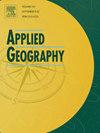远程办公如何影响日常和居住的流动性:瑞士工作和生活的新地理
IF 4
2区 地球科学
Q1 GEOGRAPHY
引用次数: 0
摘要
远程办公的实践经历了革命性的转变,从根本上重塑了工作和生活方式的选择。与许多其他地区一样,瑞士也经历了这一转变的显著加速,2019冠状病毒病大流行推动远程办公从疫情前的25%上升到2022年的37.1% (FSO, 2023)。远程办公的激增可能会重新评估人们如何参与他们的职业生活,为拥有不同生活方式和生命历程的个人提供新的可能性。本文探讨了远程办公对日常和住宅流动性的影响,重点是瑞士的背景。我们的研究解决了两个关键问题:首先,远程办公如何影响通勤模式,以及由此产生的对日常流动性的反弹效应。其次,由于远程办公,居住环境发生了哪些变化,它们如何影响移动性或不移动性,以及居住地点的选择。为了回答这些问题,我们分析了一项特别调查(n = 5 ' 100)。我们将讨论远程工作实践、社会人口因素、流动性和居住情况。我们的核心结果是,远程办公减少了通勤频率,同时促进了住宅的不动,但增加了工作场所和住宅之间的距离。本文章由计算机程序翻译,如有差异,请以英文原文为准。
How does telework impact daily and residential mobilities: New geographies of working and living in Switzerland
The practice of telework has undergone a transformative shift, fundamentally reshaping work and lifestyle choices. Switzerland, like many other regions, experienced a remarkable acceleration of this shift, with the COVID-19 pandemic propelling telework from 25% of the workforce before the outbreak to 37.1% by the year 2022 (FSO, 2023). This surge in telework adoption has potentially enabled a re-evaluation of how people engage with their professional lives, offering new possibilities for individuals with diverse lifestyles and life course situations. This article explores the implications of telework on daily and residential mobility, focusing on the Swiss context. Our research addresses two key questions: Firstly, how does telework influence commuting patterns, and what are the resulting rebound effects on daily mobility. Secondly, what transformations occur in residential situations because of telework, and how do they influence mobility or immobility, and the choice of residence locations. To answer these questions, we analyze an ad hoc survey (n = 5′100). We will be discussing teleworking practices, socio-demographic factors, mobilities, and residential situations. Our central result is that telework reduces commuting frequencies while facilitating residential immobility but creating longer distances between workplaces and residences.
求助全文
通过发布文献求助,成功后即可免费获取论文全文。
去求助
来源期刊

Applied Geography
GEOGRAPHY-
CiteScore
8.00
自引率
2.00%
发文量
134
期刊介绍:
Applied Geography is a journal devoted to the publication of research which utilizes geographic approaches (human, physical, nature-society and GIScience) to resolve human problems that have a spatial dimension. These problems may be related to the assessment, management and allocation of the world physical and/or human resources. The underlying rationale of the journal is that only through a clear understanding of the relevant societal, physical, and coupled natural-humans systems can we resolve such problems. Papers are invited on any theme involving the application of geographical theory and methodology in the resolution of human problems.
 求助内容:
求助内容: 应助结果提醒方式:
应助结果提醒方式:


